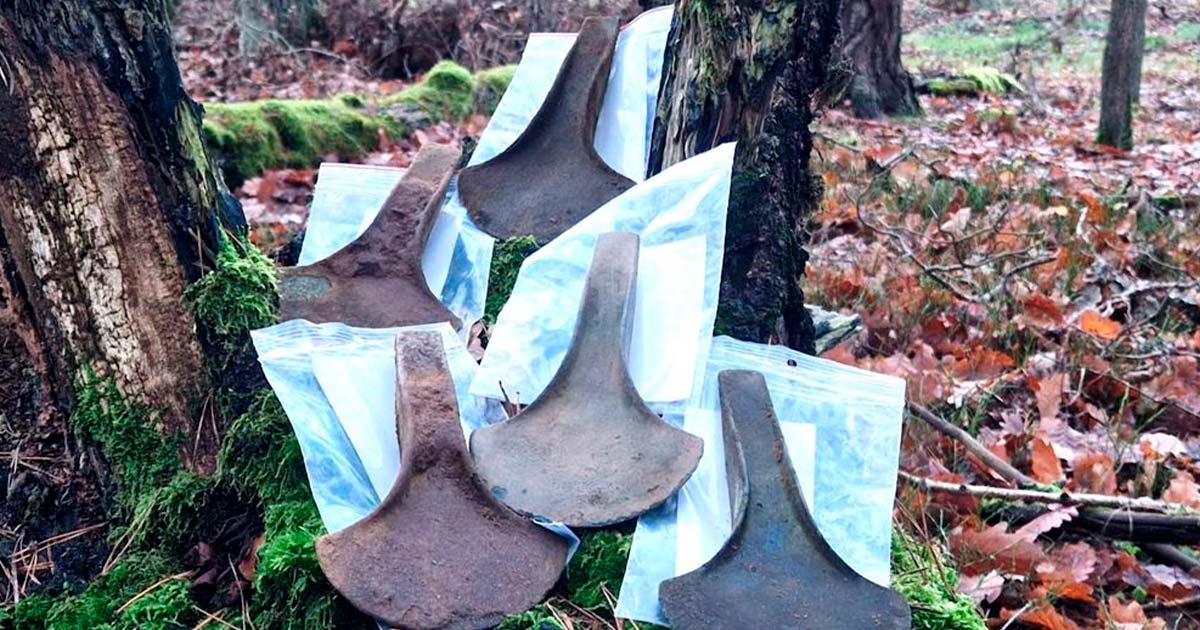‘Sensational’ 3,500-year-old Bronze Age Axes Found in Forest in Poland
An amateur treasure hunter has made a remarkable find, unearthing five Bronze Age axe heads in near-perfect condition. The artifacts date from 1700 to 1300 BC, are believed to potentially link to a Baltic culture from contemporary Lithuania or northeastern Poland.

One of the axe blades discovered at Starogard Forest District, Ploland. (Nadleśnictwo Stargard)
The First News has reported the axes to have been found amongst the trees in the Starogard Forest District, near Szczecin, in the north-west corner of Poland, near the border with Germany.
The discovery of the axes was initially made by Denis Konkol, a metal detector enthusiast, who had been granted formal authorization by the Provincial Office for the Protection of Monuments to search the site, explains The History Blog. Upon uncovering the axes, he immediately took steps to secure the area and notified the relevant officials. Following this, the monument conservator from Gdańsk carried out an excavation of the location.
- The Hidden Story of Poland: What Happened to the Forgotten Kingdom of Lechia?
- Huge Hoard of 1000-year-old Yotvingian Weapons Unearthed in Poland

The authorities excavating the Bronze Age axes at a relatively shallow depth of 20-30 cm. (Nadleśnictwo Stargard)
A Rare and Valuable Find
Such discoveries are rare in the region, and Igor Strzok, the Pomeranian Provincial Conservator of Monuments explained that, “The last find of this type of weapon or tool was discovered about 20 years ago in the Lublin region”, quoted The First News.
Bronze Age finds in this area typically consist of bracelets or breastplates, making the unearthing of these axe heads particularly unusual and significant. A wider search of the area threw up the find of a 2,000-year-old fibula (fastening brooch), but no other Bronze Age items.
- The Forgotten Celtic History of Ancient Poland
- Complete 2,500-Year-Old Scythian Harness Discovered in Poland

A more modern (2000-year-old) fibula (brooch fastener) found in a wider search of the area. (Nadleśnictwo Stargard)
A Shallow Grave
Piotr Klimaszewski from the Pomeranian Provincial Office for the Protection of Historical Monuments noted that the treasure hunter found the axe heads buried approximately 20-30 centimeters underground in a small pit beneath turf and humus. This seems to be a very shallow hole for items dating from around 3,500 years ago.
The axes, of the tautušiai type, named after the village in Lithuania where they were first discovered, noted The History Blog. They are notable for their large size, featuring slender handles with raised edges and broad blades.
Due to the almost perfect condition in which they were found, experts speculate they were new blades hidden in hurry, or perhaps even a ritual offering of some kind.
These historically valuable Bronze Age axe heads will be transferred to the Archaeological Museum in Gdańsk for further examination and study.
Top image: The collection of five Bronze Age axe blades leaning against a tree in the forest where they were found. Source: Nadleśnictwo Stargard
By Gary Manners

















